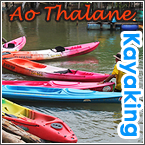Thailand’s favourite fish
March 28, 2010 by admin
Filed under Local Delicacy
‘Pla thu’ has a prime place in the culinary culture of Thailand
If there is a fish that is close to the heart of Central Thailand’s culinary tradition it is probably the pla thu, a type of mackerel that goes ideally with nam phrik kapi, the iconic chilli dip sauce. But there are several varieties of pla thu, including types found off the China coast and in Indonesian waters. The one that Thais like best, and which inhabits the Gulf of Thailand, is not especially big and is notable for its oily meat and its appetising aroma and flavour. Its life cycle involves a certain amount of travel. The mother lays her eggs in southern Thai waters where there are rocky reefs to protect them. When they hatch, the tiny fry gradually make their way to the Gulf of Thailand, and the closer they get to the part of the gulf that they are seeking, with its muddy bottom, the more food they find. It abounds in the muddy-bottomed sea off of Samut Songkhram and Phetchaburi, where the fish grow to full size and their meat reaches maximum quality. It is in these places that the best and tastiest pla thu are caught. The fish that aren’t caught by fishermen return to the South to breed and the cycle is repeated. Since the entire life cycle takes place in Thai waters, this variety of pla thu is considered to be a Thai fish. It is one fish that is eaten by Thais in every part of the country.
People who live near rivers prefer to eat freshwater fish and dislike sea fish because of their odour. But they make an exception for the pla thu and concede that it is delicious. Thirty years ago a candidate seeking election in Isan bought votes by handing out dried and salted pla thu to villagers. He won, and the price he paid was cheap because he only had to give a few fish to each household. When visiting friends in Laos, the most welcomed gift to bring along is a few of these same dried, salted pla thu, or perhaps some mussels preserved the same way. This species of mackerel is a kind of “miracle fish” that can be used to make almost 100 dishes that range from the extremely
simple to complex recipes that are difficult to prepare. The fish used can be fresh, steamed or dried and salted. Even the innards, including the belly and intestines, are important ingredients for food. In the South they are mixed with salt and fermented for a couple of days. Then the liquid is used to make kaeng tai pla, the most delectable of southern Thai curries. In the Central Region the pla thu innards are fermented in the same way, then eaten with minced lemon grass, shallots and bird chillies sprinkled on top. Fresh pla thu can be prepared in a great number of ways. About 30 years ago people in the Phetchaburi area would ferment the fresh fish with salt for about eight months and then strain the result to get just the liquid, which was used as an excellent nam pla. If this version of nam pla is no longer available, it is only because pla thu has risen so steeply in price. In the Amphawa district of Samut Songkhram, locals wrap the fish in banana leaves and roast them in a coconut husk fire. The smoke scents the fish, which are then eaten with nam pla Mon, a sauce made by mixing nam pla with sugar, lime juice, krachai (an aromatic root), chillies and ginger. This is a simple dish exclusive to the farmers of Amphawa, as the nam pla Mon is a speciality of theirs. Pla thu tom khem is another tasty pla thu dish. To make it, a salty broth must first be made from nam pla, sugar and tamarind juice, then sticks of sugar cane are placed on the bottom of the pot. Cleaned fresh pla thu are then added and cooked slowly over a low fire for many hours. The longer they simmer, the more the fish will be flavoured by the broth as the meat becomes firmer and the bones become so soft they almost dissolve. This dish is delicious as is, but to make it even more delicious chop some shallots and bird chillies and sprinkle them over the fish, then serve with hot rice. It’s all you need for a great meal. Fresh pla thu can also be cooked chuchee-style. Chuchee dishes using fish are made by frying curry seasonings with coconut cream until the mixture becomes very thick, almost dry, then adding the fish. Only fish without scales can be used. People who live near fresh water will use local types like pla nuea awn, pla kot or pla khao and will sprinkle slivered kaffir lime leaves and chillies (phrik chee fa variety) over the fish before serving. This dish is a great favourite with Thais who live near rivers and lakes, but even they will agree that when made with pla thu it is just as good as when the local, freshwater types are used. Then there is pla thu sot rat phrik sam rote. To make it, first the fresh pla thu are fried and then a three-flavoured sauce is made by frying shallots with pounded chillies, nam pla, sugar and tamarind juice, then pouring the sauce over the fish. These are only a few examples of the many dishes that can be made using fresh pla thu. But pla thu are also used in “steamed” form in a wide variety of recipes. Actually, the fish are boiled in salt water rather then steamed. In the past they were called pla thu kheng after the kheng, or small, round, woven bamboo containers in which they were displayed in the market. The ones sold in the Samut Songkhram area had their necks broken by vendors so that they appeared to be looking down. This downward-looking shape became emblematic of
pla thu from Samut Songkhram, and it originated when vendors were forced to break the necks of large fish so that they would fit into the kheng. Most pla thu were of a standard size, but big ones sometimes appeared and had to be forced to fit into the kheng for sale. With the passage of time, when the broken necks became a kind of Samut Songkhram trademark, even the smaller fish had the treatment. The steamed pla thu are the ones that are fried and served with nam phrik kapi and fresh and pickled vegetables. This dish is close to the core of the Thai culinary repertoire, a viable symbol of Thailand’s food. If it is not finished at the meal where it is first served, the nam phrik can be fried with rice and the meat of uneaten pla thu, removed from the fish, served together with it as a one-dish meal. Salted, dried pla thu are usually large fish of the kind called hang khaeng (“hard-tailed”) pla thu in Thai. They can be wrapped in several layers of banana leaf and roasted. As they cook they give off an appetising aroma, and taste wonderful when sprinkled with sliced shallots and bird chillies with a little lime juice squeezed over them. They can be eaten with all kinds of hot curries, or with congee. The pla thu is a very Thai fish, one that has a prime place in the culinary culture of each region of Thailand. If other kinds of fish were to be taken away, we could probably bear it. But if the pla thu all disappeared, we would be in a sad situation indeed.
SOURCE : http://bangkokpost.com/leisure/restaurant/34799/thailand-s-favourite-fish
















